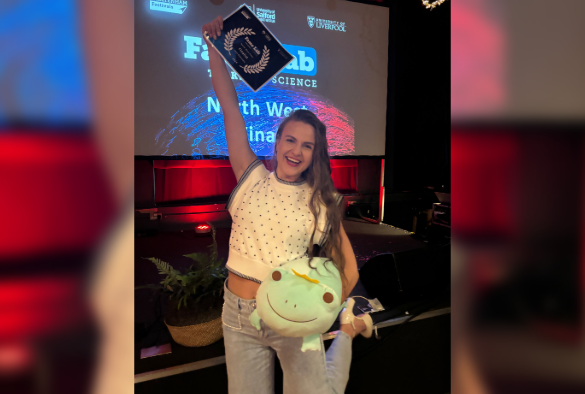
Ieva Andrulyte is a PhD student in the Institute of Systems, Molecular & Integrative Biology. Funded by the Biotechnology and Biological Sciences Research Council (BBSRC), Ieva focuses on how language is processed in the human brain.
My Journey into Neuroscience
I’ve always had a passion for science and maths. Growing up in a small city in Lithuania, I knew that if I wanted to pursue a career in research, I’d need to move abroad. Despite struggling with English, I took it as a challenge—hired an English tutor, worked hard, and eventually got accepted to study in the UK. At the University of East Anglia (UEA), I studied Molecular Biology and Genetics. While I enjoyed learning about cell biology and genetics, I quickly realised that working in a wet lab wasn’t for me. I broke a pipette, burnt a microscope slide, and had my fair share of failed experiments. These experiences didn’t discourage me from science, but they did make me reconsider where I could best apply my skills.
That’s when I discovered bioinformatics, a field of science that develops methods and software tools for understanding biological data. In my second year, I reached out to a bioinformatics professor and started working in his lab. This was my first experience with computational biology, and I instantly connected with it. I learned programming languages like R and Bash and realised this was the direction I wanted to take. After graduating, I had a decision to make. I had offers to study bioinformatics, but something didn’t feel right. One night, while reading science news and browsing university programmes, I came across neuroimaging and neuroscience. I’d always been fascinated by the brain, and that night, I realised neuroscience combined everything I loved: science, maths, and computation. Without much hesitation, I applied for a Master’s in Neuroimaging at the University of Manchester, and that’s when I found my true passion.
Understanding Language in the Brain
My PhD at the University of Liverpool focuses on how language is processed in the human brain—specifically, language lateralisation. This refers to how our brain organises language in one hemisphere. While in most people language is largely under the control of the left hemisphere (left side of the brain), around 10% of people use the right or both hemispheres. Why this happens is still a mystery. One hypothesis is that structural differences in the brain might explain why some people use different hemispheres for language.
Over the past century, researchers have studied brain structure and language processing, but we still don’t have all the answers. The old idea was that there’s a specific “language centre” in the brain responsible for all aspects of language. But now we know that language processing involves complex networks of white matter tracts that connect different regions of the brain. My research focuses on understanding these networks and how they contribute to language lateralisation.
So far, I’ve conducted several analyses to explore these connections. I’ve worked closely with my supervisors and colleagues, and I’ve also expanded my network through collaborations. One highlight of my research journey was attending the Neurohackademy summer school at the University of Washington, where I learnt the programming language, Python and worked with others to develop a tool that integrates structural and functional brain measures to predict language lateralisation. Another key moment was a three-month research visit to the University of Bordeaux, where I used new software and data to better understand white matter tracts. The findings from this visit have contributed to some of the more exciting chapters in my PhD thesis.
Real-World Impact: From Research to Clinical Practice
Knowing which hemisphere of the brain a person uses for language is crucial in cases of epilepsy or tumour surgery. Currently, functional MRI (fMRI) is the gold standard for determining language lateralisation, but it requires patients to remain still for long periods, which can be challenging for some people. Even after identifying the functional side of the brain, surgeons need to consider the structural pathways connecting those areas to avoid damaging critical language regions during surgery. For instance, I’ve found that people who use both hemispheres for language processing have better connectivity in the corpus callosum, the largest white matter tract that connects the two hemispheres. This is important because in epilepsy cases, a surgery called callosotomy is often performed to prevent seizures from spreading between hemispheres. Now, if the patient uses both hemispheres for language, removing the corpus callosum could lead to language difficulties. My research underscores the importance of incorporating both functional and structural information into pre-surgical planning to prevent accidental damage.
Beyond My PhD
One of the things I’m most passionate about is sharing science with others. Throughout my PhD, I’ve given talks at science competitions, public events, universities, and high schools. I also share my life as a PhD student on Instagram (@andrulyte), where I talk about everything from my research to my accomplishments and failures. I’ve met so many amazing people through this platform, and I hope to continue sharing my journey even after I complete my PhD.
Looking forward, I’m excited to continue contributing to neuroscience and inspiring others to explore careers in STEM.